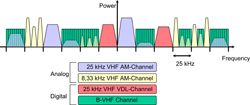Removing the bottleneck in air traffic communications
Air traffic management (ATM) is a complicated process relying on sophisticated communications equipment and able personnel to ensure safe and punctual travel. In fact, aeronautical safety communications have a globally dedicated frequency spectrum, the VHF COM (very high frequency communication) range encompassing 118–137 MHz. This means that all air traffic safety communications are transmitted and received within this frequency range and no other entity may transmit and receive in this range. The VHF COM is broken down into voice channels, windows of 25 kHz or 8.33 kHz bandwidths, and each air traffic control (ATC) sector is assigned a unique voice channel. Increasing numbers of pilots in the skies mean rising numbers of communications between pilots and their dedicated ATC in a given voice channel and thus increased likelihood of interference and potential danger. In short, we are nearing our saturation limit. The EU-funded ‘Broadband VHF aeronautical communications system based on MC-CDMA’ (B-VHF) project conducted a detailed feasibility analysis of the use of multi-carrier code-division multiple access (MC-CDMA) technology for aeronautical communications in the VHF band for a future broadband VHF (B-VHF) system. MC-CDMA technology is used in high capacity, multiple-user telecommunications systems. It is essentially a method of sharing a given frequency spectrum among multiple users to minimise interference. The B-VHF system increased both voice and data link capacity and services compared to traditional VHF systems. The researchers ensured that the design concepts were fully compatible with operation in the VHF COM frequency range as well as in others anticipated for future aeronautical applications. This compatibility translates to excellent cost effectiveness as the B-VHF system could be applied as an overlay system and coexist with the present VHF infrastructure. In summary, the B-VHF project demonstrated the feasibility of a novel broadband VHF system for ATC based on cutting-edge fourth generation technology and capable of being used in tandem with the current VHF system. Implementation of the results should alleviate the ATC saturation expected to be noticeable soon while ensuring safety in the skies and punctuality on the ground.







